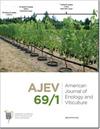New Rapid, Simple, and Cheap Methods to Determine Tyramine in Fermented Beverages and Culture Medium
IF 1.8
3区 农林科学
Q3 BIOTECHNOLOGY & APPLIED MICROBIOLOGY
引用次数: 0
Abstract
Fermented beverages are frequently contaminated with biogenic amines, produced by lactic acid bacteria that exhibit decarboxylase activity. Wine spoilage can occur when increased tyramine concentrations creates a product harmful to consumers. Determination of tyramine is important because it elevates blood pressure, which might cause a migraine attack in susceptible persons. We developed two rapid, inexpensive, and simple methods, a colorimetric technique and a thin-layer chromatography technique, to determine tyramine concentrations in culture medium and wine without complicated extraction procedures. The new colorimetric method showed high correlation between absorbance and tyramine concentrations from 1.0 to 100 mg/L in Moeller culture broth and red wine (r2 = 0.9995 and 0.9988, respectively). Thin-layer chromatography (nTLC) with a new visualization reagent also demonstrated a high correlation among tyramine concentrations between 5.0 and 100 mg/L and absorbance, with an r2 of 0.988. Both new methods showed a high correlation with high-performance liquid chromatography (colorimetric method, r2 = 0.9995; nTLC, r2 = 0.9982) and exhibited good tyramine recovery (>83%). The detection limit of the two new methods was comparable with existing analytical methods. The new assays are simple, inexpensive, and do not require any laborious pre-treatment of the samples. Both methods are suitable for routine analysis to quickly and safely monitor tyramine in a research or wine quality control laboratory. The methods were validated in various matrices: in culture media frequently used in microbiology laboratories, in common Argentine wine varietals, such as Cabernet Sauvignon and Torrontés, and in other fermented beverages, such as sparkling wine, cider, and craft beer.快速、简单、廉价测定发酵饮料和培养基中酪胺的新方法
发酵饮料经常被生物胺污染,这些生物胺是由乳酸菌产生的,它们具有脱羧酶活性。当酪胺浓度增加产生一种对消费者有害的产品时,葡萄酒就会变质。酪胺的测定很重要,因为它会升高血压,这可能会导致易受影响的人偏头痛发作。我们开发了两种快速、廉价、简单的方法,比色法和薄层色谱法,以测定培养基和葡萄酒中的酪胺浓度,而不需要复杂的提取程序。该比色法在1.0 ~ 100 mg/L的Moeller培养液和红酒中酪胺浓度与吸光度呈高度相关(r2分别为0.9995和0.9988)。新型可视化试剂薄层色谱法(nTLC)显示酪胺浓度在5.0 ~ 100 mg/L范围内与吸光度呈高度相关,r2为0.988。两种新方法与高效液相色谱法(比色法,r2 = 0.9995;nTLC, r2 = 0.9982),酪胺回收率良好(>83%)。两种新方法的检出限与现有分析方法相当。新的检测方法简单、廉价,并且不需要对样品进行任何费力的预处理。这两种方法都适用于研究或葡萄酒质量控制实验室快速、安全地监测酪胺的常规分析。这些方法在各种基质中进行了验证:微生物实验室中经常使用的培养基,常见的阿根廷葡萄酒品种,如赤霞珠和torront,以及其他发酵饮料,如起泡酒、苹果酒和精酿啤酒。
本文章由计算机程序翻译,如有差异,请以英文原文为准。
求助全文
约1分钟内获得全文
求助全文
来源期刊

American Journal of Enology and Viticulture
农林科学-生物工程与应用微生物
CiteScore
3.80
自引率
10.50%
发文量
27
审稿时长
12-24 weeks
期刊介绍:
The American Journal of Enology and Viticulture (AJEV), published quarterly, is an official journal of the American Society for Enology and Viticulture (ASEV) and is the premier journal in the English language dedicated to scientific research on winemaking and grapegrowing. AJEV publishes full-length research papers, literature reviews, research notes, and technical briefs on various aspects of enology and viticulture, including wine chemistry, sensory science, process engineering, wine quality assessments, microbiology, methods development, plant pathogenesis, diseases and pests of grape, rootstock and clonal evaluation, effect of field practices, and grape genetics and breeding. All papers are peer reviewed, and authorship of papers is not limited to members of ASEV. The science editor, along with the viticulture, enology, and associate editors, are drawn from academic and research institutions worldwide and guide the content of the Journal.
 求助内容:
求助内容: 应助结果提醒方式:
应助结果提醒方式:


